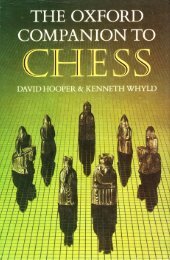Create successful ePaper yourself
Turn your PDF publications into a flip-book with our unique Google optimized e-Paper software.
<strong>The</strong> evenl thlt kindled the enlhusilsn ol<br />
problcmhts qas thc publication of Lov.DAyi<br />
problem showing lhe Indian thene in Feb. 1845.<br />
For a long ine Slaunion reprinted il nonthly on<br />
ihe covcrolhis magazinc, hc and othcn dc.laring<br />
ir lo be the grealest problem ever composed.<br />
Problemins lound nany ne* ways oI showing<br />
citical play, Loveday\ ieBarkable inlendon.<br />
rouRNrrs for composcn bcgar in thc 1850s.<br />
Thc winner of the Bris<strong>to</strong>l <strong>to</strong>uney ol i861 vas<br />
the Englishman Frank Healey (1828 1906), and<br />
the Brislol theme becane almost !s tanous as the<br />
lndian thene. For ihc Lo.don <strong>to</strong>urncy. 1862.<br />
norc than 400 problems Nere submiited: tbe<br />
winner Nas rhe Austnan onposer Confud Bayer<br />
(1828 97)wbo becanelhellrslolrhe greal<strong>to</strong>urncy<br />
In thc sccond halfolthc 1gth cenrury ihere Nere<br />
diffcrenr ideas as io lhe form a problen should<br />
take. Tbe BoEEMAN style, fien as now. empha<br />
sized MoDEL uES. For rhe so callcd Old Ccrman<br />
sttle BrRGri madc a codc oI slandards in 1884:<br />
problems were <strong>to</strong> be rHREE Movms or MoRE<br />
MovERs, diifrcult <strong>to</strong> solve, Nnh Dany larialionsand<br />
with somc nodcl matcsithc pa$n lormarion<br />
sbould seem natural, as iI it might have arise! in<br />
play: ds far as possible Whne-s noves should nor<br />
"7*. %<br />
'&<br />
%<br />
iry. %t<br />
7&r&%<br />
iffi v&t<br />
atffit*l<br />
67b,t<br />
%, r&a%<br />
d%%<br />
A problen <strong>by</strong> o rr. S.r,.rp<strong>to</strong>bleme , lAlA. Afiet<br />
I Od2 h6 2 ND several variations show nodel<br />
2...K93 3Nxe4+ Kf,l 4Ng3andnow4 ..<br />
(xg3 5Nfl or4...Kxe5 5 Nag,l<br />
2 . . . Be3 3 Nex84+ KI5 4 Nxh6+ Kx.5 5<br />
Neg4.<br />
INnoDUooRl Pi.AY (1 Qd2 h6) is added ro make<br />
tne problem harde. <strong>to</strong> solve and also, perh.ps, <strong>to</strong><br />
increase rhe nunber oi non lorcctul movcs. B,<br />
onnling this the probl.m could be sel as a mate in<br />
loui. Ccncrally probleN in thls style bad les<br />
xhite pieces (else nodel nates could not be<br />
achieved) and, unllne Bohemian problems, a lair<br />
nrnber olwhite pavns, often used lo guard {har<br />
would otheMise be FLrcEr salAREs.<br />
In Aneiic. .oyD was composing problens ol<br />
quile a djllerenl kiad. His aim sas <strong>to</strong> pnzzle and<br />
amuse. Neither solving dilficulty nor variations<br />
were souSht as ends in rhenselles and unham-<br />
PROBLEM IIISTORY 265<br />
pcrcd <strong>by</strong>the need lo prcvidemodelm.les he {as<br />
able<strong>to</strong> develop!wide rlnBeotide.s. Hisproblems<br />
{ere ingenious rather lha. complcx and showed<br />
distinct thcmes in sharply pointed form. He Nas<br />
followed <strong>by</strong>sENru$ rvho explored sone possibi<br />
hies ot the nurale Gee Br.oc() aid thc sclrmate.<br />
(For exanples of lhc work of these tNo see rurNo,<br />
rHdr. and PT.GNTNNY.)<br />
In EnCland composeB sought neat.ess oI conslruction,<br />
pleasing scttings, and good cr moles<br />
lbr all of which they evolved lhen osn artisric<br />
crircria, and the avoidance oi lesser DUAIsi in<br />
shorr, a concern sirh lorm althoueb content was<br />
nor disrcgardcd. <strong>The</strong> leading exponents sere<br />
n.ArHCorE aDd Percy Francis Blake (1873-1936).<br />
horh oftrhom.ifre lolhe iore inlhc lS9G.lForan<br />
exanple oI the English style applied lo a two<br />
nolel sec (NGT WHLEL,)<br />
Mosl problenists supposed lhal lhe diffcrcnl<br />
srylcs ol the lale 19fi cenlurywould mcrgc in<strong>to</strong> a<br />
univeBd stvle; but thc chanecs thal besan in tbe<br />
neq centur! rcscmblcd a renaissance raDer tban a<br />
Iusion. As regards three .nd nore mov.rs thc<br />
principal foundes ol thc ic$ movcmeot were<br />
rcErz and (oc(Fr.rcRN who pubiished lbeir<br />
lamous book D,s /dn.nc r/o6la in 1903 <strong>The</strong>y<br />
drcs then hpiration f<strong>to</strong>m the lransidonalperiod,<br />
in particul.r iron the lndian froblcm whcn the<br />
criical move madc its lint appeamnce Problens<br />
$erc <strong>to</strong> shoiv ihemes and <strong>to</strong> show then in lhe<br />
clearest nannerj il natural' senings, pure males,<br />
or solling dilncufty could aho bc shown, so nuch<br />
the bctl.r. but all such considerations Bere ro be<br />
subordinated ro purnyoiain(Z e.k4inh.n). Th.<br />
manner ot achieving the malc was <strong>to</strong> be of nore<br />
inporra.ce than thc mating posiiion. Tbese ideas<br />
eere ncarcr lo those ol Loyd whom the rulhors<br />
praise rhan ro those oi Berger's code Although<br />
odly fitical play is eaamincd in D6 /dn.n.<br />
Prorlm thc authors and olher composeE soo.<br />
dcmonsrrated rhar many themes could be used in<br />
accordance Nith the ner cnGria. <strong>The</strong>problem art<br />
urs enn.hed lor theie,re ihcmcs that.annot be<br />
shown il model mates are io be achieled. More<br />
move6 in this 'NeN Gern.n' style cane io be<br />
called loeical probteos- logical in the scnsc lhat a<br />
single idea doni.ales thc play. a rcquirementthat<br />
ncccssaril], Iimits thc nnmbe. ol vanalions <strong>The</strong><br />
solution may consist ol a single Iine ot play sith<br />
variet! achieved <strong>by</strong> w.y ofhies rhai relatc in some<br />
* aI lo the soiurion. (For problems b, tbe founden<br />
scc.RrrrcAL sau^tu and Ntu<strong>to</strong> rwo MovER.)<br />
the rvo'MovER, hnher<strong>to</strong> conparalilely .eglecred,<br />
also receiled a ne$ inlusion of lile, unity in<br />
rhis case hcing a.hieled <strong>by</strong> lhe provislo. oI<br />
variations thal relare <strong>to</strong> one another in some Nay.<br />
In i904 A. F.<br />
abic <strong>to</strong> shos a<br />
.Ross cHEc( in ca.h of thrce variations. Soon<br />
conposcrs began ro fearure E^LF p'Ns. lNprNSbatredes.<br />
hallbattenes. inlerlerence, and olher<br />
tacdcalelenenh, sonetimes uing onc ofthcm nl<br />
several vaiatio.s (whi.h are thus linked), son,




